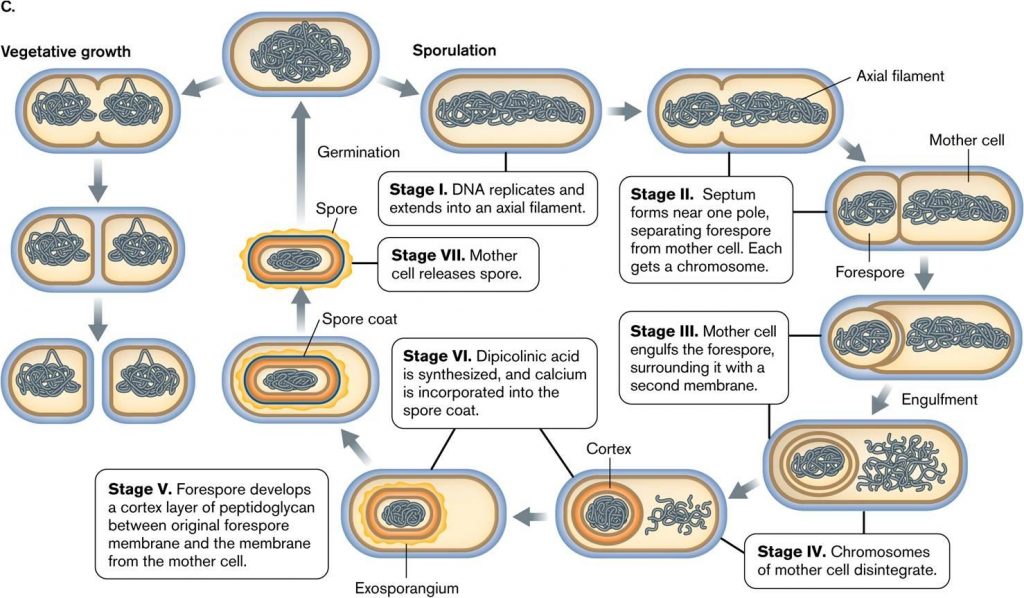
Bacterial Spore: structure, types, sporulation and germination
- Spore is metabolically dormant structure produced during unfavorable condition by the process called sporulation
- Sporulation occur during late log phase or early stationary phase
- Under favorable condition spores germinate to give vegetative cell.
- Size: 0.2 µm
- Spore are resistant to nutrition starvation, temperature, extreme pH, antibiotics etc
Structure of endospore:

An endospore has following layers
- Exosporium
- Spore coat
- Cortex
- core
Exosporium:
- It is the outermost layer made up of protein that encloses spore coat.
- In some bacterial spore, exosporium is made up of polysaccharide and lipid.
Spore coat:
- It is thick double layered covering that encloses cortex
- Spore coat consists of spore specific protein, mainly contains cysteine and hydrophobic amino acids. Due to presence of these aminoacids,spore are resistant to adverse environmental condition.
Cortex:
- Inside the Spore coat, there is cortex made up of loosely arranged peptidoglycan layer.
- Inner layer: comprises about 20% of peptidoglycan, it is tightly arranged
- Outer layer: it is loosely arranged, it can be hydrolysed during spore germination.it comprises alalnine (55%), tetra-peptide (15%) and muramic lactum (30%).
Core:
- It is the innermost part of spore
- It is also known as spore protoplast
- Core consists of core wall, cytoplasmic membrane, cytoplasm, nucleoid, ribosomes and other cellular materials.
- Core contains (10-25%) water so, the cytoplasm is gel like
- It contains high amount of calcium and dipicolinic acid in the form of calcium dipicolinate (10-15% by dry weight).
- Core also contains high percentage of small acid soluble protein (SASP).
- SASP is synthesized during sporulation and it binds to DNA in core and protect it from potential damage caused by UV radiation, desiccation and drying.
- In addition, SASPs also provides nutrition and energy for spore germination.
Types of bacterial spore
1. Endospore:
- It is produced within the bacterial cell.
- Bacteria producing endospore are: Bacillus, Clostridium, Sporosarcina etc
2. Exospore:
- It is produced outside the cell
- Bacteria producing exospore: Methylosinus
Sporulation
- During unfavorable condition, vegetative cell converts into spore by the process known as sporulation
- Sporulation can be divided into several stages. In Bacillus subtilis, entire process of sporulation takes 8 hours to complete from stage 0 to stage VII
Stages of sporulation:

Stage 0
- Normal conditions of a vegetative cell
Stage I: Axial filament formation stage
- In this stage bacterial chromosome become thread like known as axial filament
- Axial filaments attached to cytoplasmic membrane by mesosome
- Elongation of cell take places
- PHBA is the reserved food material in Bacillus spp is utilized in sporulation.
Stage II: forespore formation
- Asymmetric cell division occurs
- Cell membrane forms septum near one end which encloses a small portion of DNA forming forespore
Stage III: engulfment of forespore
- Mother cell membrane grow around the forespore engulfing it.
- Fore spore now has two membrane layer
Stage IV: synthesis of exosporium
- Chromosome of mother cell disintegrates
- Exosporium synthesis occurs
- Forespore starts Forming primodial cortex between two membrane.
- Dehydration of cell
Stage V: synthesis of dipicolonic cacid
- Production of SASPs and dipicolinic acid occurs
- Incorporation of calcium ions with dipicolonic acid occur forming calcium dipicolonate
- Further dehydration of cytoplasm
- Formation of coat layer
Stage VI: maturation
- Maturation of endospore
Stage VII: release of endospore
- Cell lysis and release of endospore
Spore germination
- Endospore remains dormant for years. But under favorable conditions each endospore germinates to give rise to a vegetative cell.
Spore germination involves 3 process.
- Activation
- Germination
- Outgrowth
Activation of endospore:
- The germination of bacterial spore do not occur even when the environment is favorable unless it is first activated.
- At first the Spore coat must be damaged by heating for several minutes.
Germination:
- The activated spore initiates germination after binding of effector molecules.
- Binding of effectors molecules activates autolysis that destroy peptidoglycan of cortex.
- After destruction of peptidoglycan, water is taken up and calcium dipicolinic acid is released.
Outgrowth:
- After uptake of water swelling of spore occurs.
- Along with swelling, synthesis of DNA, RNA and proteins also occurs.
- A small germ cell emerges out after breaking the Spore coat and begins to grow into vegetative cell.
